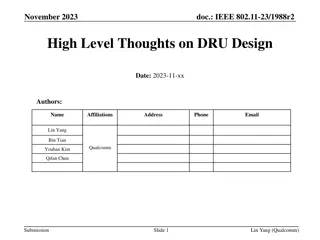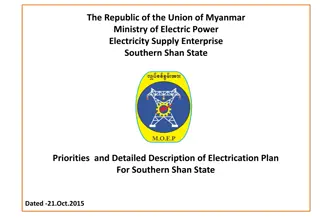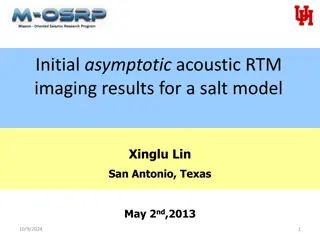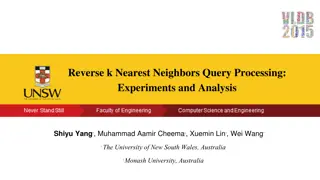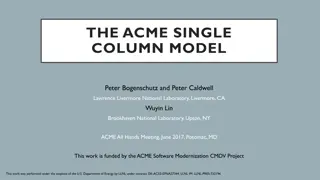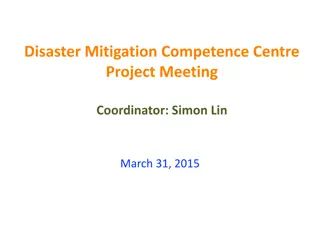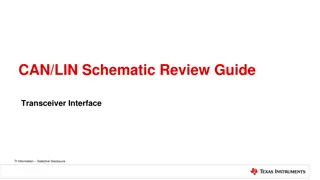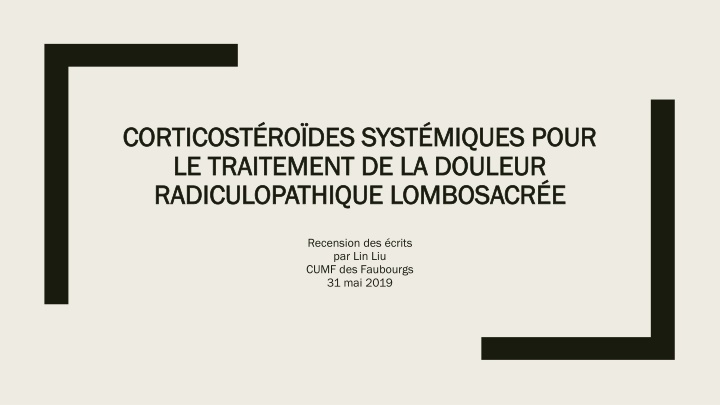
Treatment of Lumbar Radiculopathy with Systemic Corticosteroids - Research Review
Explore the efficacy of systemic corticosteroids for treating lumbar radiculopathy based on a systematic research review. The study focuses on reducing pain and improving functional status in adults with this condition. Findings suggest potential benefits of oral or intramuscular corticosteroids compared to placebo or other treatments.
Download Presentation

Please find below an Image/Link to download the presentation.
The content on the website is provided AS IS for your information and personal use only. It may not be sold, licensed, or shared on other websites without obtaining consent from the author. If you encounter any issues during the download, it is possible that the publisher has removed the file from their server.
You are allowed to download the files provided on this website for personal or commercial use, subject to the condition that they are used lawfully. All files are the property of their respective owners.
The content on the website is provided AS IS for your information and personal use only. It may not be sold, licensed, or shared on other websites without obtaining consent from the author.
E N D
Presentation Transcript
CORTICOSTRODES SYSTMIQUES POUR CORTICOST RO DES SYST MIQUES POUR LE TRAITEMENT DE LA DOULEUR LE TRAITEMENT DE LA DOULEUR RADICULOPATHIQUE RADICULOPATHIQUE LOMBOSACR LOMBOSACR E E Recension des crits par Lin Liu CUMF des Faubourgs 31 mai 2019
La douleur radiculaire lombosacre Pr valence vie 3 5 % Hommes = femmes Source importante de morbidit et invalidit fonctionnelle M canisme : compression de la racine par hernie discale et rel che de mol cules inflammatoires Infiltrations pidurales : difficiles obtenir https://www.health.harvard.edu/pain/sciatica
OBJECTIF P P Adultes avec douleur radiculopathique lombosacr e I I Corticost roides oraux ou intramusculaires Placebo ou autre traitement de douleur radiculopathique C C O O Diminution de la douleur
MTHODOLOGIE Recherche syst matique dans 4 bases de donn es PubMed, Medline, Embase et le Cochrane Central Register of Randomized Controlled Trials (CENTRAL) Ann es : 1970-2018 Mots cl s employ s : systemic corticosteroids , prednisone , sciatica , radiculopathy , etc. filtres humans et clinical trials Recherche manuelle dans revues de litt rature, lignes directrices et UpToDate
CRITRES DE SLECTION INCLUSION INCLUSION EXCLUSION EXCLUSION tude clinique randomis e corticost ro des non-syst miques patients adultes avec douleur radiculopathique lombaire corticost ro des intraveineux issues mesur es incluant diminution de douleur interventions n cessitant assistance par imagerie ou monitoring
MTHODOLOGIE Limite de 4 articles qualit m thodologique crit re d exclusion Issue principale : R duction de la douleur Issue secondaire : Am lioration statut fonctionnel
HOLVE, 2008 Devis ECR double-insu Population Adultes, Sciatalgie de novo x 1 semaine n n = 27 Prednisone per os Intervention 60mg x 3 jours, 40mg x 3 jours, 20mg x 3 jours Contr le placebo Issue primaire Douleur (CI 95%) Issue secondaire Fonctionnement (CI 95%) Roland-Morris Pain Rating Scale 2 sem : -3.6 (-21.6, 14.4) Roland-Morris Disability Score 2 sem : -10.5 (-29.9, 8.9)
Roland-Morris Disability Questionnaire chelle valid e pour mesurer statut fonctionnel, autorapport par patient Total de 24 points
FRIEDMAN 2008 Devis ECR double-insu Population Adultes, Sciatalgie de novo x 1 semaine n n = 82 Methylprednisolone acetate 160mg IM x1 (= 175mg prednisone) Intervention Contr le placebo Issue primaire Douleur (CI 95%) Issue secondaire Fonctionnement (CI 95%) Numerical Rating System, suppl mentaire du pointage 1 sem : 1.1 (-0.5, 2.8) 3 sem : 1.3 (-0.2, 2.7) Roland-Morris Disability Score, % patients avec invalidit quelconque : 19% cortico vs 49% placebo (p=0.004)
GOLDBERG 2015 Devis ECR double-insu Population Adultes, Sciatalgie de novo x 3 mois n n = 269 Intervention Prednisone per os 60 mg x 5 jours, 40mg x 5 jours 20mg x 5 jours Contr le placebo Issue primaire Douleur (CI 95%) Issue secondaire Fonctionnement (CI 95%) Numerical Rating System 3 sem : -0.3point ( 0.4 - 1.0; p=0.34) Score ODI 3 sem : suppl mentaire 6.4 points (1.9 10.9; p=0.006)
Oswestry Disability Index chelle valid e pour mesurer statut fonctionnel, autorapport par patient Total de 100 points
SANGBONG 2016 Devis ECR Population Adultes, Sciatalgie n n = 54 Intervention Triamcinolone 4mg per os BID x 14jours puis ?? Pregabalin 75 mg per os BID x 14 jours OU Gabapentin 100 mg per os TID x 14 jours Contr le Issue primaire Douleur (CI 95%) Issue secondaire Fonctionnement (CI 95%) Numerical Rating System, pointage moyen 2 sem : 3.8 2.8 corticost ro des vs 4.3 2.4 placebo (p<0.001) Diminution Score ODI 6 sem : 8.9 7.3 corticost roides vs 10.4 6.8 placebo (p=0.246)
DISCUSSION : DOULEUR 3 tudes n gatives Manque puissance de 2 tudes 1 tude positive Mais risque de biais important Tendance g n rale favorisant corticost roides si sciatalgie x 1 semaine Lien avec m canisme d action ?
DISCUSSION : FONCTIONNEMENT 2 tudes positives Friedman : plus de patients bipolaires ? Effets secondaires Gain tr s modeste : E.g. 6,5 points sur chelle ODI de 100 points
LIMITES DE LA RECENSION H t rog n it importante entre les tudes Doses / voie administration / outils de mesures variables Radiculopathie objectiv e par IRM ou non Spectre limit 4 articles Mais tudes ant rieures n gatives
Auteur Auteur Ann e Ann e (n) (n) Intervention Intervention Contr le Contr le R sultat R sultat Dexamethasone phosphate oral Pas de diff rence significative par rapport au placebo Hofferberth Hofferberth 1970 100 placebo Pas de diff rence par rapport au placebo sur la douleur, paresth sie, faiblesse musculaire, disruption des r flexes, signe de Las gue, ou dur e d hospitalisation Dexamethasone phosphate IM Prosman Prosman 1979 52 placebo Dexamethasone IM Pas de diff rence par rapport au placebo Hedeboe Hedeboe 1982 39 placebo Pas dexamethasone soulagement en aigue ou long terme de la douleur lombosacr e de sup riorit du le pour Dexamethasone oral Hairmovic Hairmovic 1986 33 placebo radiculaire
CONCLUSION de preuves convaincantes pour appuyer l usage des corticost ro des oraux ou IM pour traiter la douleur radiculopathique lombosacr e 2 tudes sugg rant l ger b n fice fonctionnel, mais effets secondaires Patients s v rement invalides : d cision partag e ? Pour le futur : tudes plus rigoureuses et larges chantillons, avec patients avec douleur plus aigue
RFRENCES Holve RL, Barkan H. Oral steroids in initial treatment of acute sciatica. J Am Board Fam Med 2008;21:469-74. Friedman BW, Esses D, Solorzano C, Choi HK, Cole M, Davitt M, et al. A randomized placebo-controlled trial of single- dose IM corticosteroid for radicular low back pain. Spine 2008;33:e624-9. Goldberg H, Firtch W, Tyburski M, et al. Oral steroids for acute radiculopathy due to a herniated lumbar disk: a randomized clinical trial. JAMA 2015; 313:1915. Ko S, Kim S, Kim J, Oh T. The Effectiveness of Oral Corticosteroids for Management of Lumbar Radiating Pain: Randomized, Controlled Trial Study. Clin Orthop Surg. 2016;8(3):262 267. Hofferberth B, Gottschaldt M, Grass H, Buttner K. [The usefulness of dexamethasonephosphate in the conservative treatment of lumbar pain a double-blind study (author s translation).] Arch Psychiatr Nervenkr 1982;231:359-67. Porsman O, Friis H. Prolapsed lumbar disc treated with intramuscularly administered dexamethasonephosphate. A prospectively planned, double-blind, controlled clinical trial in 52 patients. Scand J Rheumatol 1979; 8:142. Hedeboe J, Buhl M, Ramsing P. Effects of using dexamethasone and placebo in the treatment of prolapsed lumbar disc. Acta Neurol Scand 1982;65:6-10. Haimovic IC, Beresford HR. Dexamethasone is not superior to placebo for treating lumbosacral radicular pain. Neurology 1986;36:1593-4.



